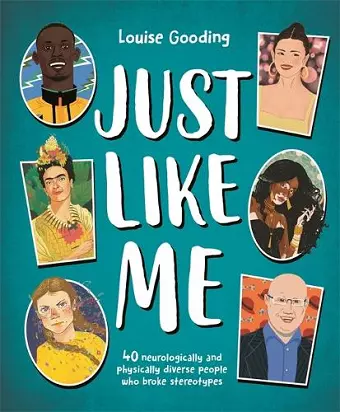Just Like Me
40 neurologically and physically diverse people who broke stereotypes
Louise Gooding author Melissa Iwai illustrator Caterina Delli Carri illustrator Angel Chang illustrator Dante Hookey illustrator
Format:Paperback
Publisher:Bonnier Books Ltd
Published:4th Jul '24
Should be back in stock very soon

An anthology of 40 inspirational figures who are neurologically or physically diverse.
Each story includes struggles and triumphs, a motivational quote and information on each condition.
Reflective of our diverse society, this book features Simone Biles, Selena Gomez, Temple Grandin, Warwick Davis, Daniel Radcliffe, Ellie Simmonds, Greta Thunberg and many more.
The world is full of people who are a little different. Our uniqueness makes us who we are. We are all 'different; not less'.
This is a collection of the true stories of 40 inspirational figures from around the world, all of whom are physically or neurologically diverse. Each story includes struggles and triumphs, a motivational quote and information on each condition.
Reflective of our diverse society, this book features Simone Biles, Selena Gomez, Temple Grandin, Warwick Davis, Daniel Radcliffe, Ellie Simmonds, Greta Thunberg and many more.
Our uniqueness makes us who we are. This glorious anthology encourages us to celebrate this uniqueness and recognise our potential to achieve whatever we want.
The 40 neurologically and physically diverse people introduced in this book have done just that. They have all smashed stereotypes, overcome misconceptions and shown the world just what they are capable of. There's a fascinatingly eclectic range of names, including both the globally famous (like Usain Bolt and Richard Branson) but also the lesser known, like Turia Pitt (who survived a fire with 65 per cent burns) and Nkosi Johnson (who was born with HIV). All their profiles are brought to life with absorbing biographies, inspiring quotes, facts and colourful portraits by four different artists.
Plus there's a wealth of surprising facts and fascinating details to be discovered and discussed along the way. Who knew that Daniel Radcliffe had dyspraxia? Have you ever seen Frida Kahlo pictured in a wheelchair? And can you spot Matt Haig's "black dog"?
The author (who has ADHD) sets out to prove to neurodivergent children that you can overcome any potential limitations of a label, but in doing so she has also created an absorbing and highly attractive book relevant to any and every child.
Gooding's debut profiles 40 famous people with disabilities.
The author, a mother of children with disabilities, opens the book with a note about her desire to find role models for her children. To that end, she alphabetically introduces racially diverse disabled people from around the world and throughout history. Diagnoses range from autism to limb difference. Historical figures include Japanese peace advocate Sadako Sasaki, who developed leukemia after the bombing of Hiroshima, and American abolitionist Harriet Tubman, who led fellow slaves to freedom despite epilepsy. Contemporary figures include athletes, authors, and entertainers: Polio survivor and Paralympian Malathi Krishnamurthy-Holla remains "one of the fastest female Indian athletes in a wheelchair"; Japanese nonverbal author Naoki Higashida penned popular books describing autism; English actor Daniel Radcliffe deals with dyspraxia, a coordination disorder; and Australian Madeline Stuart is the first professional model with Down syndrome. Each profile begins with an uplifting quote and concludes with a sidebar explaining the subject's disability. Unfortunately, some sidebars emphasize colloquial over scientific terms. For instance, Stephen Hawking's disability is named eponymously (Lou Gehrig's disease), "also known as ALS," instead of with its scientific name, amyotrophic lateral sclerosis. Occasionally, vague phrasing creates confusion, such as when the author writes that a speech-generating device enabled Hawking to communicate by using a "touchpad." (A hand clicker became his primary input method.) Various illustrators' realistic renditions of smiling subjects complement the upbeat (albeit somewhat dry) text.
Inspirational but occasionally unclear.
This really helped me identify with other people with similar conditions to me and helped me feel inspired -- Callum2010 * Toppsta *
Absolutely love this diverse book! When my youngest is old enough, it will be a book I share with him also. We don't have any books like this, so it was so exciting. There were people of all races, abilities etc and it was so refreshing to read about all the different people. There were some people in there I had never heard of, so it was great for me to learn about new people. There is someone in this book that anyone reading it, could relate to, which is why I really like the book. Love the way it shows how people can be very different, but are all special and can do amazing things -- Katie-birmingham * Toppsta *
A beautiful non-fiction book celebrating individuality and uniqueness.
An excellent resource and teaching tool to give others a better understanding of some of the many neurological and physical differences people have and that a label need not define us.
I highly recommend this book, it should be in all schools libraries.
ISBN: 9781800784321
Dimensions: 230mm x 191mm x 9mm
Weight: 310g
96 pages